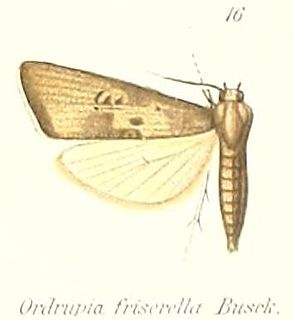
Scirpus is a genus of grass-like species in the sedge family Cyperaceae many with the common names club-rush, wood club-rush or bulrush. They mostly inhabit wetlands and damp locations.

Copromorphidae, the "tropical fruitworm moths" is a family of insects in the lepidopteran order. These moths have broad, rounded forewings, and well-camouflaged scale patterns. Unlike Carposinidae the mouthparts include "labial palps" with the second rather than third segment the longest. With other unusual structural characteristics of the caterpillar and adult, it could represent the sister lineage of all other extant members of this superfamily. The genus Sisyroxena from Madagascar is also notable for its unusual venation and wing scale sockets.

The Batrachedridae are a small family of tiny moths. These are small, slender moths which rest with their wings wrapped tightly around their bodies.

Glyphidocera is a genus of moths in the family Autostichidae.

Cyperus laevigatus is a species of sedge known by the common name smooth flatsedge.
Hyposmocoma swezeyi is a species of moth of the family Cosmopterigidae. It was first described by August Busck in 1914. It is endemic to the Hawaiian island of Oahu. The type locality is Kaimuki, Honolulu.

Lantanophaga pusillidactyla, the lantana plume moth, is a moth of the family Pterophoridae. It is native to the southern United States, Mexico, the Caribbean and South America. It was introduced to Australia accidentally in 1936 and is now found from Sydney to Cairns along the coast. It has also been introduced to Hawaii in 1902, Pohnpei in 1948 and Palau in 1960 for biological control. It has since been recorded from Yap in 1987–1988 and is now distributed on all islands of the Mariana and Caroline Islands where the host plant is found, except Aguijan.
Asymphorodes dimorpha is a species of gelechioid moth of subfamily Agonoxeninae of the palm moth family (Agonoxenidae), whose taxonomic status is disputed. Alternatively, the palm moths might be a subfamily of the grass-miner moth family (Elachistidae), with the Agonoxeninae becoming a tribe Agonoxenini.
Chedra microstigma is a tiny moth of the family Batrachedridae described in 1907. It has only been found on Oahu. It has been found feeding on sedges, plants belonging to the Cyperaceae family, and its larvae host at least three species of parasitoids in Hawaii.
Chedra mimica is a tiny moth of the family Batrachedridae known from Hawaii.
Dryadaula terpsichorella, the dancing moth, is a moth of the family Tineidae. It is native to south-eastern Polynesia, Samoa and Fiji, but has also been recorded from Hawaii and more recently from Florida and California. The common name is derived from the characteristic dancelike gyrations it goes through when it alights. It was first described by August Busck in 1910.

Amorbia emigratella, the Mexican leaf-roller, is a moth of the family Tortricidae. Although it was described from Hawaii, it is known to be a native of the southern United States, Mexico and Central America. It was first described by August Busck in 1910.

Crocidosema lantana, the lantana flower-cluster moth or lantana tortricid moth, is a moth of the family Tortricidae. It was first described by August Busck in 1910. It is native to Mexico and the southern United States, but was introduced to Hawaii in 1902, Australia in 1914 and the Caroline Islands in 1948 and 1949 to aid in the control of Lantana weeds. It has also been recorded from Yunnan, China and in Sri Lanka.
Cremastobombycia lantanella, the lantana leaf miner, is a moth of the family Gracillariidae. It was first described by August Busck in 1910. It is native to the southern United States and Mexico. It was introduced to Hawaii in 1902 to aid in the control of Lantana plants.
Bucculatrix thurberiella, the cotton leaf perforator, is a species of moth of the family Bucculatricidae. It was first described by August Busck in 1914. It is native to the south-western United States and northern Mexico. It is an introduced species in Hawaii.
Augustus Busck was a Danish-American entomologist with the United States Department of Agriculture's Bureau of Entomology. He is best known for his work with microlepidoptera, of which he described over 600 species. His collections of Lepidoptera from North America and the Panama Canal Zone are held by the National Museum of Natural History in Washington, D.C.

The Stenomatinae are a subfamily of small moths in the family Depressariidae.
Stenoma striatella is a moth in the family Depressariidae. It was described by August Busck in 1914. It is found in Panama.
Stenoma lapilella is a moth in the family Depressariidae. It was described by August Busck in 1914. It is found in Panama and Brazil.
Moca rugosella is a moth in the family Immidae. It was described by August Busck in 1914. It is found in Guyana.








